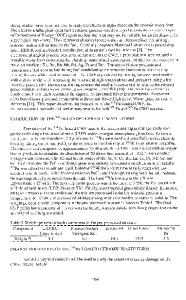The Use of Surrogates in Waste Immobilization Studies: A Case Study of Plutonium
- PDF / 264,302 Bytes
- 8 Pages / 612 x 792 pts (letter) Page_size
- 63 Downloads / 339 Views
The Use of Surrogates in Waste Immobilization Studies: A Case Study of Plutonium Paul A. Bingham, Russell J. Hand, Martin C. Stennett, Neil C. Hyatt and Mike T. Harrison1 Immobilization Science Laboratory, Department of Engineering Materials, University of Sheffield, Sir Robert Hadfield Building, Mappin Street, Sheffield S1 3JD, UK. 1 Materials and Products, Nexia Solutions Ltd, The Technology Centre, Sellafield, Seascale CA20 1PG, UK. ABSTRACT Surrogates are widely used in the research and development of nuclear wasteforms, providing detailed insight into the chemical and physical behaviour of the wasteform whilst avoiding the widespread (restricted and costly) use of radiotoxic elements in the laboratory. However, caution must be exercised when dealing with surrogates since no single element or compound perfectly mimics all aspects of the behaviour of another. In this paper we present a broad discussion of the use of surrogates in waste immobilization, drawing upon and highlighting our research into glass and ceramic wasteforms for the immobilization of bulk PuO2. INTRODUCTION The most widely used methods for the safe immobilization of radioactive nuclear wastes are cement encapsulation (LLW and some ILW) and vitrification (HLW and some ILW) [1, 2]. Other materials, particularly ceramics and glass composites, are also under consideration as hosts for the immobilization of certain specific wastes [1, 2]. The chemical composition of most radioactive and toxic wastes prevents their direct use in early stage laboratory studies. This arises for a variety of reasons: chiefly financial and safety concerns, as illustrated in figure 1. For the majority of radioactive waste immobilization studies, early stage R&D includes desk-based and small-scale laboratory studies; these are followed by larger-scale trials, eventually leading to full-scale inactive and active trials. The use of radioactive components is essential during the latter stages; however, during the earlier stages this may be unnecessary and it can be expeditious to simulate the chemical and physical behaviour of radioactive waste components using inactive surrogates. This has become standard practice in early-stage wasteform development, yet it is a methodology which is by no means perfect, and the research scientist must be aware of its limitations in order to design a sufficiently robust experimental programme. In many cases, the chemical behaviour of a radioactive element may be simulated using one of its inactive isotopes. For example, the chemical and physical effects of 90Sr, 137Cs and 129I may be safely simulated in laboratory-produced wasteforms using their naturally-occurring isotopes. However, such an approach does not consider the effects of sample irradiation due to radioactive decay. Furthermore, when dealing with wastes containing actinide elements and others such as 99 Tc, it is not possible to use inactive isotopes of the same element. In these cases it is necessary to use a surrogate element that mimics aspects of the chemical or physical prope
Data Loading...











